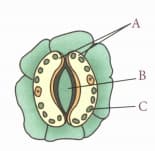Leaves: Functions and Modifications
Leaves: Functions and Modifications: Overview
In this topic, we will study the structure and important role of the leaf in the life of plants. With the help of activities, it details the process of transpiration and photosynthesis which takes place in the leaves of a plant.
Important Questions on Leaves: Functions and Modifications
Define leaf hook.
Explain the morphology of storage leaves.
Choose the plant which stores food in its leaves.
What is a storage leaf?
Write about the use of epiphyllous buds in the vegetative reproduction of plants.
Epiphyllous buds are used in the vegetative reproduction of plants.
Choose the plant that develops epiphyllous bud.
The leaves of the prickly poppy are modified into scale leaves.
Define scale leaf.
Choose the plant that has scale leaf.
Leaf spines help to reduce the loss of water through _____ in xeric conditions.
Give an example for leaf modified into tendrils.
Give an example for leaf modified into pitcher.
Give an example for leaf modified into spines.
_____ is seen in aquatic plant such as Utricularia.
Wild pea and glory lily are examples of _____(leaf tendrils/leaf spines).
Given below are the characteristics of insectivorous plants. Identify the plant.
The bladder sucks the small organisms through partial vacuum, so through a trap door these organisms can go in but cannot come out.
Given below are the characteristics of insectivorous plants. Identify the plant.
The front part of petiole is coiled like a tendril that holds the pitcher in erect position. The leaf tip forms the lid. The pitcher-shaped leaf is filled with a liquid to passively collect the insect and digest it.
Look at the given figure and Label the marked parts:
Which of the following structure is involved in both photosynthesis and transpiration process?

